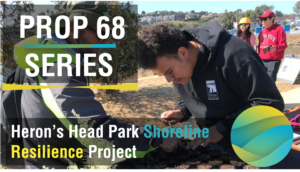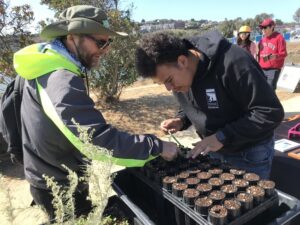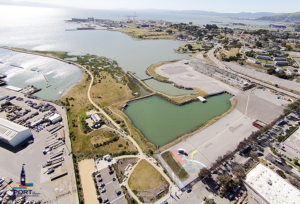Prop 68 Climate Resilience Miniseries Episode 5: Heron’s Head Shoreline Resilience Project
(Intro to the series here)
“We spend a lot of our lives hearing about how humans are negatively affecting the environment…and we don’t always hear about the exciting good things we do for the environment–and this project is one of those” – Erica Petersen
Today we are at Heron’s Head Park in San Francisco to meet with members of the team leading a large project that will use nature to engineer resilience to erosion and sea level rise. This project seeks to protect this highly accessible and valuable wetland habitat for future generations. 
“With this project we get to demonstrate these natural infrastructure techniques for shoreline protection. These dynamic solutions to climate change and sea level rise are going to be so important over the coming decades, it’s great to start to install them now and learn from them and build the knowledge and scientific basis for applying these [nature-based solutions] throughout the state,” comments Eddie Divita, lead ESA designer on the project.
The shoreline at Heron’s Head Park has been eroding for the past 20 years and so to prevent further erosion this project will construct a coarse material beach and an adjacent offshore oyster reef to dampen the wave action that is currently pounding the shore. “Every year that we don’t control shoreline erosion, we’re losing marsh,” notes Carol Bach, Lead Project Manager.

Photo courtesy Literacy for Environmental Justice
This Prop 68 project also includes the restoration of endangered tidal marsh plant, Suaeda californica, or the California sea-blite; this plant grows tall and climbs, providing ideal high tide refuge for bird and mammal species seeking cover to avoid predators while also staying dry. Over time, the team expects the coarse material beach to develop a wave-built berm. To stabilize the berm and provide high-tide refuge for marsh animals, Dr. Katharyn Boyer and her team of San Francisco State University undergraduate and graduate students in partnership with the community-based non profit education organization, Literacy for Environmental Justice (LEJ), will plant S. californica using plants raised by LEJ Eco-Apprentices.
Boyer has used this “arboring” technique at other sites throughout San Francisco Bay and is optimistic that the S. californica restoration at Heron’s Head will provide critical habitat for species such as the federally-endangered Ridgway’s Rail and salt marsh harvest mouse. “We can use a federally endangered plant to support some federally endangered animal species,” adds Boyer.

Photo courtesy Bionic Landscape Architects
San Francisco Bay is an ideal location for this type of project: “the Bay is directly connected to the outer coast of California, it drains 40 percent of the state’s watershed, and supports many endangered and endemic species,” says Marilyn Latta, Project Manager for the State Coastal Conservancy. “This project is part of an overall regional blueprint for the Bay to bring back not only tidal wetlands, with a goal to restore 100,000 acres of tidal wetlands within the Bay, but also to restore the subtidal habitats that we so rarely see…seagrasses, oyster reefs, sandy bottom, mudflats,” adds Latta.
This Prop 68 Project serves as an exemplary case study for how nature-based solutions can be designed and implemented across the state. “This project is a piece of a larger puzzle for how to build resilient and adaptive shorelines in California in the face of climate change and sea level rise,” notes Bach.
To learn more about this project, check out this video!
Resources:
Baylands Ecosystem Habitat Goals Project
New Life for Eroding Shorelines Project
EcoCenter at Heron’s Head Park
Credits:
Video/Photos provided by Katharyn Boyer, Carol Bach, Literacy for Environmental Justice, Kathryn Beheshti, Katherine Smith, Aric Crabb, Peter Baye, and Chris Cochems
About Carol Bach: Carol is the Environmental Affairs Manager for the Port of San Francisco. Carol has been the lead Project Manager for the Heron’s Head Shoreline Resilience Project through the conceptual design, planning, and permitting phases.
About Rod Iwashita: Rod is the Chief Harbor Engineer for the Port of San Francisco. Rod oversees the project at-large and is responsible for ensuring that the project is successful.
About Erica Petersen: Erica is a Project Manager for the Port of San Francisco. Erica will be managing the construction phase of this project.
About Marilyn Latta: Marilyn is a Project Manager for the State Coastal Conservancy. She has been a long-time champion for Living Shorelines projects across the state and has offered technical assistance on this and many other similar projects.
About Eddie Divita: Eddie is a Civil Engineer with Environmental Science Associates. Eddie works for the consulting company that is leading the design of the project.
About Dr. Katharyn Boyer: Katharyn is a Professor of Biology at San Francisco State University. She received the 2021 Coastal and Estuarine Research Federation William A. Niering Outstanding Educator Award for her dedication to education and mentoring the next generation of ecologists, coastal managers, practitioners, and stewards. Her lab at the Estuary & Ocean Science Center will be leading the Suaeda Restoration at Heron’s Head. Katharyn received her B.S. in Zoology at the University of Maryland, her M.S. in Biology at San Diego State, and her Ph.D. in Biology at University of California, Los Angeles.
About the Author: Dr. Kathryn Beheshti is a 2021 California Sea Grant State Fellow with the Ocean Protection Council’s Climate Change Program. Kat’s own research focuses on understanding the drivers of loss and recovery of key coastal foundation species (e.g. salt marsh plants and seagrasses). Kat is committed to making science accessible to individuals of all ages and demographics. She hosts her own science communication platform, sloughit.com and participates in an interdisciplinary science communication team at SciAll.org, where she is a Lead Vlogger.

